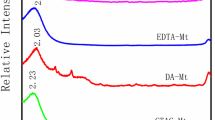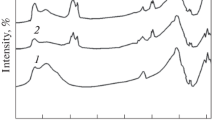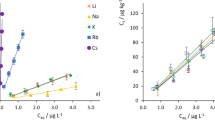Abstract
Single- and bi-solute sorption and desorption of 2,4-dichlorophenol (2,4-DCP) and 2,4,5-trichlorophenol (2,4,5-TCP) in montmorillonite modified with hexadecyltrimethylammonium (HDTMA) were investigated using multi-step sorption and desorption procedure. Effect of pH on the multi-step sorption and desorption was investigated. As expected by the magnitude of octanol-water partition coefficient, K ow , both sorption and desorption affinity of 2,4,5-TCP was higher than that of 2,4-DCP at pH 4.85 and 9.15. For both chlorophenols, the protonated speciation (at pH 4.85) exhibited a higher affinity in both sorption and desorption than the predominant deprotonated speciation (about 95% and 99% of 2,4-dichlorophenolate and 2,4,5-trichlophenolate anions at pH 9.15, respectively). Desorption of chlorinated phenols was strongly dependent on the current pH regardless of their speciation in the previous sorption stage. Freundlich model was used to analyze the single-solute sorption and desorption data. No appreciable desorption-resistant (or non-desorbing) fraction was observed in organoclays after several multi-step desorptions. This indicates that sorption of phenols in organoclay mainly occurs via partitioning into the core of the pseudo-organic medium, thereby causing desorption nearly reversible. In bisolute competitive systems, sorption (or desorption) affinity of both chlorophenols was reduced compared to that in its single-solute system due to the competition between the solutes. The ideal adsorbed solution theory (IAST) coupled to the single-solute Freundlich model successfully predicted bisolute multi-step competitive sorption and desorption equilibria.
Similar content being viewed by others
References
Boyd, S. A., Shaobai, S., Lee, J.-F. and Mortland, M. M.: 1988, ‘Pentachlorophenol sorption by organo-clays’, Clays Clay Miner. 36(2), 125–130.
Burris, D. R. and Antworth, C. P.: 1992, ‘In situ modification of aquifer material by a cationic surfactant to enhance retardation of organic contaminants’, J. Contam. Hydrol. 10(4), 325–337.
Chiou, C. T. and Kile, D. E.: 1998, ‘Deviations from sorption linearity on soils of polar and nonpolar organic compounds at low relative concentrations’, Environ Sci. Technol. 32(3), 338–343.
Crocker, F. H., Guerin, W. F. and Boyd, S. A.: 1995, ‘Bioavailability of naphthalene sorbed to cationic surfactant-modified smectite clay’, Environ. Sci. Technol. 29(12), 2953–2958.
Dentel, S. K., Bottero, J. Y., Khatib, K., Demougeot, H., Duguet, J. P. and Anselme, C.: 1995, ‘Sorption of tannic acid, phenol, and 2,4,5-trichlorophenol on organoclays’,Water Res. 29(5), 1273–1280.
DiVincenzo, J. P. and Sparks, D. L.: 2001, ‘Sorption of the neutral and charged forms of pentachlorophenol on soil: Evidence for different mechanisms’, Arch. Environ. Contam. Toxicol. 40(4), 445–450.
Kan, A. T., Fu, G., Hunter, M. A. and Tomson, M. B.: 1997, ‘Irreversible adsorption of naphthalene and tetrachlorobiphenyl to Lula and surrogate sediments’, Environ. Sci. Technol. 31(8), 2176–2185.
Kan, A. T., Fu, G., Hunter, M., Chen, W., Ward, C. H. and Tomson, M. B.: 1998, ‘Irreversible adsorption of neutral organic hydrocarbons – experimental observations and model predictions’, Environ. Sci. Technol. 32(7), 892–902.
Kim, Y. S., Song, D.-I., Jeon, Y. W. and Choi, S. J.: 1996, ‘Adsorptions of organic phenols onto hexadecyltrimethylammonium-treated montmorillonite’, Sep. Sci. Technol. 31(20), 2815–2830.
Kim, D. G., Song, D.-I. and Jeon, Y. W.: 2001, ‘pH-dependent sorptions of phenolic compounds onto montmorillonite modified with hexadecyltrimethylammonium cation’, Sep. Sci. Technol. 36(14), 3159–3174.
Kleibaum, D. G. and Kupper, L. L.: 1978, Applied Regression Analysis and Other Multivariable Methods, Duxbury Press, North Scituate, MA, pp. 71–77.
McGroody, S. E., Farrington, J. W. and Gschwend, P. M.: 1998, ‘Comparison of in situ and desorption sediment-water partitioning of polyaromatic hydrocarbons and polychlorinated biphenyls’, Environ Sci. Technol. 32(1), 172–177.
Nye, J. V., Guerin, W. F. and Boyd, S. A.: 1994, ‘Heterotrophic activity of microorganisms in soils treated with quaternary ammonium compounds’, Environ. Sci. Technol. 28(5), 944–951.
Radke, C. J. and Prausnitz, J. M.: 1972, ‘Thermodynamics of multi-solute adsorption from dilute liquid solutions’, AIChE J. 18(4): 761–768.
Stapleton, M. G., Sparks, D. L. and Dentel, S. K.: 1994, ‘Sorption of pentachlorophenol to HDTMA-clay as a function of ionic strength and pH’, Environ. Sci. Technol. 28(13), 2330–2335.
Van Olphen, H.: 1977, Note on the preparation of clay suspension, In: An Introduction to Clay Colloid Chemistry, 2nd edn., Wiley-Interscience, New York, NY. 318 pp.
Weber, Jr., W. J. and Huang, W.: 1996, ‘A distributed reactivity model for sorption by soils and sediments. 4. Intraparticle heterogeneity and phase-distribution relationships under nonequilibrium conditions’, Environ. Sci. Technol. 30(3), 881–888.
Xing, B., Pignatello, J. J. and Gigliotti, B.: 1996, ‘Competitive sorption between atrazine and other organic compounds in soils and model sorbents’, Environ. Sci. Technol. 30(8), 2432–2440.
Xu, S. and Boyd, S. A.: 1995, ‘Cationic surfactant adsorption by swelling and non-swelling layer silicates’, Langmuir 11(7), 2508–2514.
Yen, C. Y. and Singer, P. C.: 1984, ‘Competitive adsorption of phenols on activated carbon’, J. Environ. Eng. 110(5), 976–989.
You, C. N. and Liu, J. C.: 1996, ‘Desorptive behavior of chlorophenols on contaminated soils’, Water Sci. Tech. 33(6), 263–270.
Zhu, L. and Chen, B.: 2000, ‘Sorption behavior of p-nitrophenol on the interface between anion-cation organobentonite and water’, Environ. Sci. Technol. 34(14), 2997–3002.
Author information
Authors and Affiliations
Corresponding author
Rights and permissions
About this article
Cite this article
Kim, JH., Shin, W.S., Song, DI. et al. Multi-Step Competitive Sorption and Desorption of Chlorophenols in Surfactant Modified Montmorillonite. Water Air Soil Pollut 166, 367–380 (2005). https://doi.org/10.1007/s11270-005-6329-5
Received:
Accepted:
Issue Date:
DOI: https://doi.org/10.1007/s11270-005-6329-5




